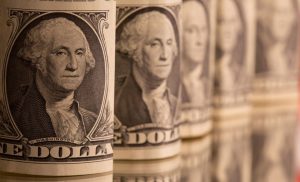No place to hide: Dollar’s surge cuts across markets
May 6, 2022

LONDON, May 6 (Reuters) – “Our currency, your problem,” were the words of a former U.S. Treasury secretary in 1971 to other finance ministers aghast at the dollar’s surge. More than 50 years on, relentless dollar strength is again leaving a trail of destruction in its wake.
The U.S. currency vaulted to two-decade highs this week, and its strength is tightening financial conditions just as the world economy confronts the prospect of a slowdown.
The surge threatens “to damage the broader market environment and expose the economic and financial cracks in the system,” said Samy Chaar, chief economist at Lombard Odier.
The 8% gain in the dollar index this year may not reverse in the near future.
Safe-haven appeal for the greenback is intact, with a dollar financing stress indicator from Barclays near its highest level in seven years. And analysis of past peak-to-trough ranges implies the dollar index could rise another 2% to 3%, Barclays said.
Here are some areas affected by the dollar’s muscle-flexing:
IMPORTED INFLATION
The dollar’s latest bout of strength has hit other G10 currencies, from the British pound to the New Zealand dollar, as well as those from developing countries that have big balance of payments deficits.
Even the quintessential safe-haven Swiss franc has not been spared, trading near a March 2020 low versus the greenback.
While currency weakness normally benefits export-reliant Europe and Japan, the equation may not hold when inflation is high and rising, as imported food and fuel become costlier as do companies’ input costs.
Euro zone inflation hit a record 7.5% this month and Japanese lawmakers are fretting that the yen, at 20-year lows, will inflict damage on households. Half of Japanese firms expect higher costs to hurt earnings, a survey found. read more
But growth concerns may prevent central banks, especially in Europe and Japan, from tightening policy in line with the Federal Reserve. Many reckon that could push the euro down to parity with the dollar, a level unseen since 2002.
“With economic recession risk present, who cares how hawkish the ECB (European Central Bank) is or what is priced into the rates curve?,” Societe Generale strategist Kit Juckes said.
TIGHTER FINANCIAL CONDITIONS
A rising dollar helps to tighten financial conditions, which reflect the availability of funding in an economy.
Goldman Sachs, which compiles the most widely used financial conditions indexes (FCI), says a 100-basis-point tightening in its FCI can crimp growth by one percentage point in the following year.
The FCI, which factors in the impact of the trade-weighted dollar, shows global conditions are at their tightest since 2009. The FCI has tightened by 104 basis points since April 1. While equity and bond selloffs had a bigger impact, the dollar’s more than 5% rise in this period will have contributed as well.
EMERGING MARKET PROBLEMS
Almost all past emerging market crises were linked to dollar strength. As the dollar rises, developing countries must tighten monetary policy to head off falls in their own currencies. Not doing so would exacerbate inflation and raise the cost of servicing dollar-denominated debt.
This week, India implemented an unscheduled interest rate rise while Chile put in a bigger-than-expected 125-basis-point rate hike.
Median foreign-currency government debt in emerging markets stood at a third of GDP by the end of 2021, Fitch estimates, compared to 18% in 2013. Several countries are already seeking assistance from the International Monetary Fund and World Bank, and further dollar strength could add to those numbers.
Investors are increasingly wary. Emerging market currencies (.MIEM00000CUS) are at a Nov. 2020 low, while the premium demanded to hold EM dollar bonds versus Treasuries is up some 100 basis points this year (.JPMEGDR)
COMMODITY GAIN AND PAIN
The rule of thumb is that a firmer greenback makes dollar-denominated commodities costlier for non-dollar-based consumers, eventually subduing demand and prices.
That’s yet to happen this time as problems such as the war in Ukraine and China’s COVID lockdowns hamper the production and trade in major commodities.
Dollar strength generally means higher revenues for commodity exporters such as Chile, Australia and Russia, though that is offset by higher costs for machinery and equipment.
But as rising U.S. yields and a stronger dollar threaten global growth, commodity prices are starting to suffer. JPMorgan said this week it was reducing exposure to the Chilean peso, Peruvian sol and others to position for “challenging times.”
U.S. INFLATION
The Fed might welcome a rising greenback that calms imported inflation – Societe Generale estimates a 10% dollar appreciation causes U.S. consumer inflation to decline by 0.5 percentage points over a year.
With U.S. gas prices at record levels, the dollar’s surge has so far provided little relief. Money markets expect 200 basis points of rate hikes in the United States over the remainder of the year and see the Fed’s policy rate peaking around 3.5% by mid-2023.
However, if upcoming U.S. inflation data for April show price pressures peaking, those bets could be dialled down.
Source:No place to hide: Dollar’s surge cuts across markets | Reuters

